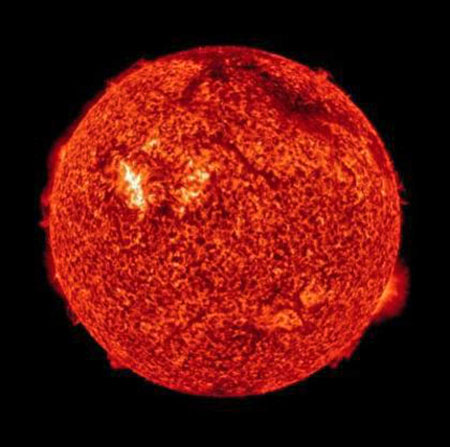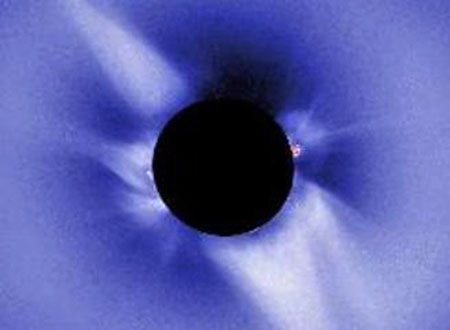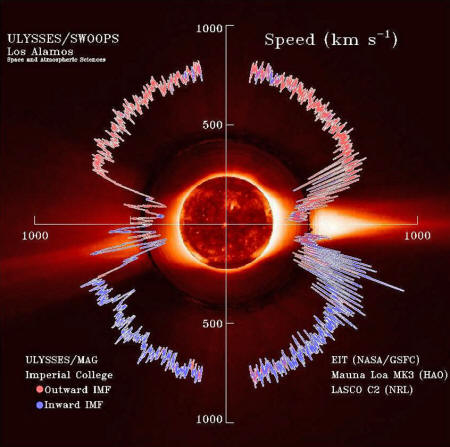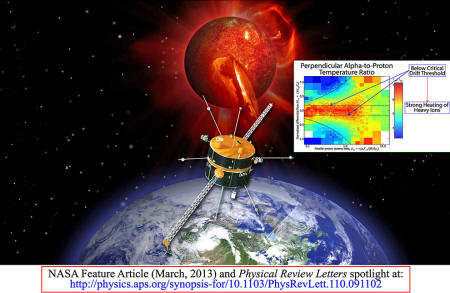|
|
|
from
PHYS Website
The observations help to answer a
60-year-old solar physics conundrum about the unexplained extreme
temperature of the Sun's corona - known as the
coronal heating problem.
They used observations of a polar coronal hole, a region of the Sun where the magnetic fields lines stretch from the solar surface far into interplanetary space.
They have posted their results at "Observational
Quantification of the Energy Dissipated by Alfvén Waves in a Polar
Coronal Hole - Evidence that Waves Drive the Fast Solar Wind"
and are presenting them at the
44th meeting of the Solar Physics Division
(SPD) of the American Astronomical Society, now in progress in
Bozeman, Montana.
A similar effect occurs on the surface of the Sun. Nuclear fusion in the center of the Sun heats the solar core to 15 million degrees. Moving away from this furnace, by the time one arrives at the surface of the Sun the gas has cooled to a relatively refreshing 6000 degrees.
But the temperature of the gas in the
corona, above the solar surface, soars back up to over a searing 1
million degrees. What causes this unexpected temperature inversion
has puzzled scientists since 1939.
Observations show both of these processes continually occur on the Sun.
But until now scientists have been
unable to determine if either one of these mechanisms releases
sufficient energy to heat the corona to such blisteringly high
temperatures.
Hahn and Savin are planning new
observations to try to address this issue.
A picture of the solar corona as seen during an eclipse. A new paper presents a model that is able to explain previously puzzling aspects of the coronal wind.
Credit: UCAR/NCAR
Meanwhile its hot outer layer (the corona) has a temperature of over a million degrees, and ejects a wind of charged particles at a rate equivalent to about one-millionth of the moon's mass each year.
Some of these wind particles bombard the
Earth, producing radio static, auroral glows, and (in extreme cases)
disrupted global communications.
A related puzzle of the solar wind is
why certain of its ions are hotter than others; one might naively
expect uniform heating of the gas, but the temperature of helium
ions, for example, is on average five times higher than that of the
much lighter mass hydrogen ions.
Writing in the latest issue of Physical Review Letters, CfA astronomers Justin Kasper and Michael Stevens, with their collaborators, present a new model that demonstrates how waves in the hot ionized gas, called "cyclotron waves," will heat the gas, and do so preferentially for heavier ions.
These waves correspond to oscillations in the circular motion of ions as they twist around the magnetic fields present.
The new model explains how energy from these waves is transferred to the particles, thereby heating them. The astronomers were able to use their new model to explain successfully the measured ion temperatures over 17 years of data accumulated from the Wind spacecraft.
The new results represent a major advance in our understanding of how the solar wind works.
March 11, 2013
Solar wind flows away from the sun
at speeds up to and
exceeding 500 km/s (a million mph).
NASA will be able to test the theory
later this decade when it sends a new probe into the sun for a
closer look.
The solar wind is a hot and fast flow of magnetized gas that streams away from the sun's upper atmosphere. It is made of hydrogen and helium ions with a sprinkling of heavier elements.
Researchers liken it to the steam from a pot of water boiling on a stove; the sun is literally boiling itself away.
Finding that "something" has been a goal of researchers for decades.
In the 1970s and 80s, observations by two German/US Helios spacecraft set the stage for early theories, which usually included some mixture of plasma instabilities, magnetohydrodynamic waves, and turbulent heating. Narrowing down the possibilities was a challenge.
The answer, it turns out, has been hiding in a dataset from one of NASA's oldest active spacecraft, a solar probe named Wind. Using Wind to unravel the mystery was, to Justin Kasper of the Harvard-Smithsonian Center for Astrophysics, a "no brainer."
He and his team processed the spacecraft's entire 19-year record of solar wind temperatures, magnetic field and energy readings and...
Ion cyclotron waves are made of protons that circle in wavelike-rhythms around the sun's magnetic field.
According to a theory developed by Phil Isenberg (University of New Hampshire) and expanded by Vitaly Galinsky and Valentin Shevchenko (UC San Diego), ion cyclotron waves emanate from the sun; coursing through the solar wind, they heat the gas to millions of degrees and accelerate its flow to millions of miles per hour.
Kasper's findings confirm that ion
cyclotron waves are indeed active, at least in the vicinity of Earth
where the Wind probe operates.
sampling the solar wind. Justin Kasper's science result is inset.
http://physics.aps.org/synopsis-for/10.1103/PhysRevLett.110.091102
The solar wind is not like wind on Earth.
Here on Earth, atmospheric winds carry nitrogen, oxygen, water vapor along together; all species move with the same speed and they have the same temperature. The solar wind, however, is much stranger.
Chemical elements of the solar wind such as hydrogen, helium, and heavier ions, blow at different speeds; they have different temperatures; and, strangest of all, the temperatures change with direction.
The ion cyclotron theory explains it:
Heavy ions resonate well with ion cyclotron waves. Compared to their
lighter counterparts, they gain more energy and heat as they surf.
Ion cyclotron waves of the type Kasper has found in the solar wind might provide a way to reverse this process.
Theoretically, they could be used to heat and/or remove the heavy ions, restoring thermal balance to the fusing plasma.
The next step, agree Kasper and Szabo, is to find out if ion cyclotron waves work the same way deep inside the sun's atmosphere where the solar wind begins its journey.
To find out, NASA is planning to send a
spacecraft into the sun itself.
The mission's goal is to sample the sun's plasma and magnetic field at the very source of the solar wind.
The research described in this story was
published in the Physical Review Letters on February 28, 2013: "Sensitive
Test for Ion-Cyclotron Resonant Heating in the Solar Wind"
by Justin Kasper et al.
Equipped with heavy shielding and double-redundant systems to safeguard against failure, the spacecraft was built to last; at least one researcher at NASA calls it the "Battlestar Gallactica" of the heliophysics fleet.
Wind has survived almost two complete solar cycles and innumerable solar flares.
|





